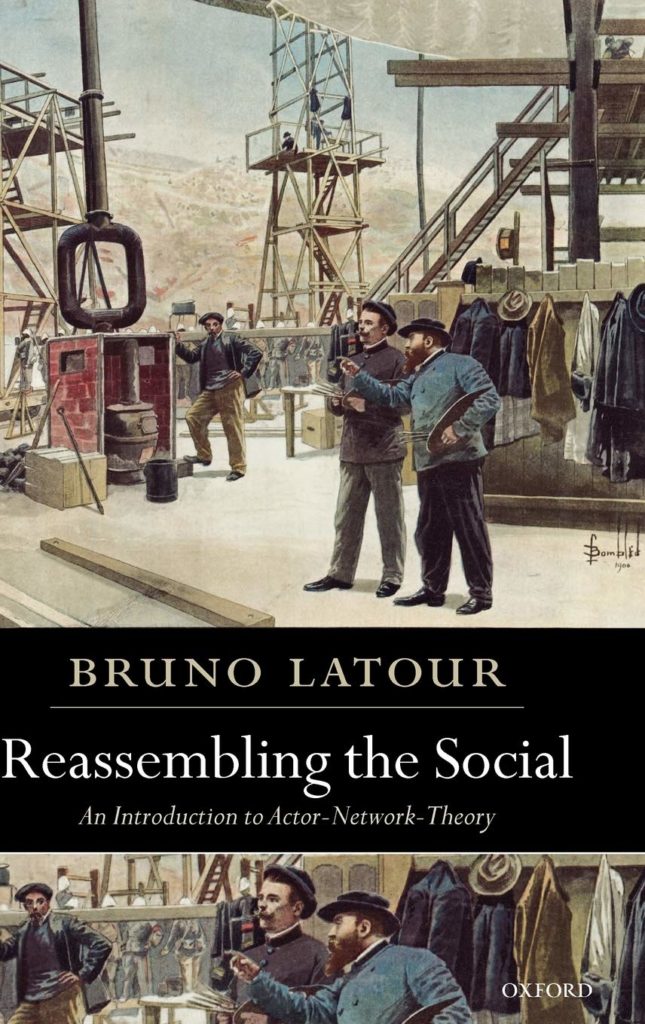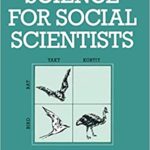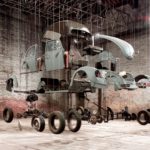
Reassembling the social (Latour 2005)
TRACE CONNECTIONS
What I want to do is to redefine the notion of social by going back to its original meaning and making it able to trace connections again. (Latour 2005:1)
NATURAL-SOCIAL ASSEMBLAGES
After having done extensive work on the ‘assemblages’ of nature, I believe it’s necessary to scrutinize more throughly the exact content of what is ‘assembled’ under the umbrella of a society. (Latour 2005:2)
QUESTÕES:
What is a society? What does the word ‘social’ mean? Why are some activities said to have a ‘social dimension’? How can one demonstrate the presence of ‘social factors’ at work? When is a study of society or other social aggregates, a good study? how can the path of a society be altered? (Latour 2005:3)
THATCHER:
Whith some provocation, this […] school of thought could use as its slogan what Mrs Thatcher famously exclaimed (but for very different reasons!): ‘There is no such thing as a society.’ (Latour 2005:5)
THING x ASSOCIATIONS:
Even though most social scientists would prefer to call ‘social’ a homogeneous thing, it’s perfectly acceptable to designate by the same word a trail of associations between heterogeneous elements. Since in both cases the word retains the same origin – from the Latin root socius – it is possible to remain faithful to the original intuitions of the social sciences by redefining sociology not as the ‘science of the social’, but as the tracing of associations. In this meaning of the adjective, social does not designate a thing among other things, like a black sheep among other white sheep, but a type of connection between things that are not themselves social. (Latour 2005:5)
UNIVERSAL SOCIOLOGY
any type of aggregate from chemical bonds to legal ties, from atomic forces to corporate bodies, from physiological to political assemblies. (Latour 2005:5)
O ENCOLHIMENTO DO SOCIAL
From the different languages, the historical genealogy of the word ‘social’ is construed first as following someone, then enrolling and alying, and, lastly, having something in common. The next meaning of social is to have a share in a commercial undertaking. […] As one can see from the drifting of the word, the meaning of social shrinks as time passes. Starting with a definition which is coextensive with all associations, we now have, in common parlance, a usage that is limited to what is left after politics, biology, economics, law, psychology, management, technology, etc., have taken their own parts of the associations. […] Because of this constant shrinking of meaning […], we tend to limit the social to humans and modern societies, forgetting that the domain of the social is much more extensive than that. (Latour 2005:6)
THE NEW NOTION OF “SOCIAL”
It has to be much wider than what is usually called by that name, yet strictly limited to the tracing of new associations and to the designing of their assemblages. […] I am going to define the social not as a special domain, a specific realm, or a particular sort of thing, but only as a very peculiar movement of re-association and reassembling. (Latour 2005:7)
SOCIOLOGY OF ASSOCIATIONS (Associology; actor-network-theory; sociology of translation; actant-rhyzome ontology; sociology of innovation)
_associations are made of ties which are themselves non-social. (Latour 2005:8)
_sociologiests should travel wherever new heterogeneous associations are made. (Latour 2005:8)
_the social […] is visible only by the traces it leaves (under trials) when a new association is being produced between elements which themselves are in no way ‘social’. (Latour 2005:8)
_our political future resides in the task of deciding what binds us all together. (Latour 2005:8)
ANT CORPUS
any study that gives non-humans a type of agency that is more open than the traditional natural causality -= but more efficient than the symbolic one. (Latour 2005:10)
THE TASKS of the SOCIOLOGIST of INNOVATION
in situations where innovations proliferate, where group boundaries are uncertain, when the range of entities to be taken into account fluctuates, the sociology of the social is no longer able to tr4ace actors’ new associations. At this point, the last thing to do would be to limit in advance the shape, size, heterogeneity, and combination of associations. To the convenient shorthand of the social, one has to substitute the painful and costly longhand of its associations. The duties of the social scientist mutate accordingly: it is no longer enough to limit actors to the role of informers offering cases of some well-known types. You have to grant them back the ability to make up their own theories of what the social is made of. Your task is no longer to impose some order, to limit the range of acceptable entities, to teach actors what they are, or to add some reflexivity to their blind practice. Using a slogan from ANT, you have ‘to follow the actors themselves’, that is try to catch up with their often wild innovations in order to learn from them what the collective existence has become in their hands, which methods they have elaborated to make it fit together, which accounts could best define the new associations that they have been forced to establish. If the sociology of the social works fine with what has been already assembled, it does not work so well to collect anew the participants in what is not – not yet – a social realism.
(Latour 2005:8)
AÇÃO-REDE É SURPREENDENTE E COLETIVA
Action is not done under the full control of consciousness; action should rather be felt as a node, a knot, and a conglomerate of many surprising sets of agencies that have to be slowly disentangled. It is this venerable source of uncertainty that we wish to render vivid again in the odd expression of actor-network. (Latour 2005:44)
AÇÃO-REDE É DISTRIBUÍDA E INCERTA
Action is borrowed, distributed, suggested, influenced, dominated, betrayed, translated. If an actor is said to be an actor-network, it is first of all to underline that it represents the major source of uncertainty about the origin of action. (Latour 2005:)
DEFINIÇÃO DE REDE
I mean by this word [network] a string of actions where each participant is treated as a full-blown mediator. (Latour 2005:128)
REDE NÃO E UMA COISA, MAS SIM UM EFEITO (fazer-fazer)
the network does not designate a thing out there that would have roughly the shape of interconnected points, much like a tele-phone, a freeway, or a sewage ‘network’. It is nothing more than an indicator of the quality of a text about the topics at hand. It qualifies its objectivity, that is, the ability of each actor to make other actors do unexpected things. (Latour 2005:129)
NETWORK IS A CONCEPT, NOT A THING
Network is a concept, not a thing out there. It is a tool to help describe something, not what is being described. It has the same relationship with the topic at hand as a perspective grid to a traditional single point perspective painting: drawn first, the lines might allow one to project a three- dimensional object onto a flat piece of linen; but they are not what is to be painted, only what has allowed the painter to give the impression of depth before they are erased. In the same way, a network is not what is represented in the text, but what readies the text to take the relay of actors as mediators. The consequence is that you can provide an actor-network account of topics which have in no way the shape of a network—a symphony, a piece of legislation, a rock from the moon, an engraving. Conversely, you may well write about technical networks—television, e-mails, satellites, salesforce—without at any point providing an actor-network account. (Latour 2005:131)
TRÊS IMPORTANTES CARACTERÍSTICAS DA REDE
.a) a point-to-point connection is being established which is physically traceable and thus can be recorded empirically;
b) such a connection leaves empty most of what is not connected, as any fisherman knows when throwing his net in the sea;187
c) this connection is not made for free, it requires effort as any fisher- man knows when repairing it on the deck. (Latour 2005:)
REPRESENTAÇÕES VISUAIS DA REDE NÃO SÃO A REDE
Yet even those limits have their advantage since the very poverty of graphical representation allows the inquirer not to confuse his or her infra-language with the rich objects that are being depicted: the map is not the territory. At least there is no risk of believing that the world itself is made of points and lines, while social scientists too often seem to believe that the world is made of social groups, societies, cultures, rules, or whatever graphic displays they have devised to make sense of their data.. (Latour 2005:133)
ANT 4 DUMMIES
Surely you’d agree that drawing with a pencil is not the same thing as drawing the shape of a pencil. It’s the same with this ambiguous word: network. With Actor-Network you may describe something that doesn’t at all look like a network—an individual state of mind, a piece of machinery, a fictional character; conversely, you may describe a network—subways, sewages, telephones—which is not all drawn in an ‘Actor-Networky’ way. You are simply confusing the object with the method. ANT is a method, and mostly a negative one at that; it says nothing about the shape of what is being described with it. (Latour 2005:142)
INTERAÇÃO É AÇÃO-REDE CONTRAÍDA
he word ‘interaction’ was not badly chosen; only the number and type of ‘actions’ and the span of their ‘inter’ relations has been vastly underestimated. Stretch any given inter-action and, sure enough, it becomes an actor-network. (Latour 2005:202)
ACABANDO COM A DISTINCÃO ESTRUTURA-AÇÃO
a ‘structure’ is simply an actor-network on which there is scant information or whose participants are so quiet that no new information is required. An ‘interaction’ is a site so nicely framed by localizers behaving as intermediaries that it can be viewed, without too much trouble, as ‘taking place locally’. (Latour 2005:202)
DEFINIÇÃO DE ATOR-REDE COMO TENDO FORMA DE ESTRELA (pq não “nó”?)
an actor-network is what is made to act by a large star-shaped web of mediators flowing in and out of it. It is made to exist by its many ties: attachments are first, actors are second. (Latour 2005:217)
any site will be taken as an actor network if it is the source of what acts at a distance on other sites—hence giving it a star-like shape—and is the end point of all the transactions leading to it—hence giving it the same star-like shape. (Latour 2005:222 nota 304)




 O LaSPA é sediado no Instituto de Filosofia e Ciências Humanas (
O LaSPA é sediado no Instituto de Filosofia e Ciências Humanas (